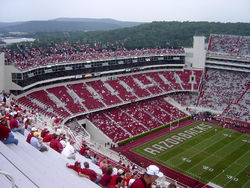History
The University of Arkansas became Arkansas' land-grant university in 1871 when Old Main was constructed atop McIlroy Hill. Kappa Sigma was founded as the first fraternity at the university in 1890, and in 1895 the Chi Omega fraternity for women (today called sorority) was created. [a 1] The group bought Lot 12, Block 3 in the Oakland Place Addition in 1928, becoming the first Greek house to own campus property.
University building superintendent Charles L. Ellis was contacted to draw up plans for the house, and construction began in 1928. The contract was awarded to the Wages Brothers who worked with James Dinwiddle, an architect and Fayetteville building inspector.
Chi Omega has expanded onto the chapter house twice, first in 1941 and again in 1958. The first addition made it possible to house 75 members and a housemother. The 1958 addition expanded the kitchen and dining room and added more bathrooms, more bedrooms, a sun porch, a porte-cochère, a study room, an office, a recreation room, and a men's room. [2]
In 2016, Chi Omega removed the 1941 and 1958 editions as part of a restoration of the 1928 structure. [3] [5] A new 9,000 square feet (840 m2) addition was added to the western side of the house, expanding its ground floor space and adding a roof deck. [3] [4] In addition, the dining room and kitchen were expanded, along with a chapter room in the basement. [3] A patio was also added to the eastern side of the house. [3] [4]
Architecture
The Chi Omega Chapter House has distinct Colonial Revival architecture with Classical Revival details. [6] It features a large front porch, a dentil course along the cornice line, and a pediment over the front entrance. [2] The chapter house also includes a suspended roof supported by four Roman doric columns. [2]
The original structure consists 10,430 square feet (969 m2); after the most recent additions, it is 38,600 square feet (3,590 m2). [3]
This page is based on this
Wikipedia article Text is available under the
CC BY-SA 4.0 license; additional terms may apply.
Images, videos and audio are available under their respective licenses.




